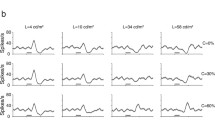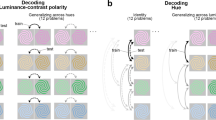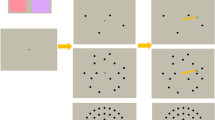Abstract
Reaction time (RT) and error rate that depend on stimulus duration were measured in a luminance-discrimination reaction time task. Two patches of light with different luminance were presented to participants for ‘short’ (150 ms) or ‘long’ (1 s) period on each trial. When the stimulus duration was ‘short’, the participants responded more rapidly with poorer discrimination performance than they did in the longer duration. The results suggested that different sensory responses in the visual cortices were responsible for the dependence of response speed and accuracy on the stimulus duration during the luminance-discrimination reaction time task. It was shown that the simple winner-take-all-type neural network model receiving transient and sustained stimulus information from the primary visual cortex successfully reproduced RT distributions for correct responses and error rates. Moreover, temporal spike sequences obtained from the model network closely resembled to the neural activity in the monkey prefrontal or parietal area during other visual decision tasks such as motion discrimination and oddball detection tasks.
Similar content being viewed by others
References
Burr DC, Corsale B (2001) Dependency of reaction times to motion onset on luminance and chromatic contrast. Vis Res 41:1039–1048
Cook EP, Maunsell JHR (2002) Dynamics of neural responses in macaque MT and VIP during motion detection. Nat Neurosci 5:985–994
Dayan P, Abbott LF (2001) Theoretical neuroscience; computational and mathematical modeling of neural systems. MIT, Cambridge, MA, London, England
Eagleman DM, Jacobson JE, Sejnowski TJ (2004) Perceived luminance depends on temporal context. Nature 428:854–856
Kinoshita M, Komatsu H (2001) Neural representation of the luminance and brightness of a uniform surface in the macaque primary visual cortex. J Neurophysiol 86:2559–2570
Koch C, Segev I (eds) (1998) Methods in neural modeling: from ions to networks. MIT, Cambridge
Mazurek ME, Roitman JD, Ditterich J, Shadlen MN (2003) A role for neural integrators in perceptual decision making. Cereb Cortex 13:1257–1269
Machens CK, Romo R, Brody CD (2005) Flexible control of mutual inhibition: a neural model of two-interval discrimination. Science 307:1121–1124
Murray IJ, Plainis S (2003) Contrast coding and magno/parvo segregation revealed in reaction time studies. Vis Res 43:2707–2719
Murthy A et al (2001) Dynamic dissociation of visual selection from saccade programming in frontal eye field. J Neurophysiol 86:2634–2637
Plainis S, Murray IJ (2000) Neurophysiological interpretation of human visual reaction times: effect of contrast, spatial frequency and luminance. Neuropsychologia 38:1555–1564
Purpura K, Kaplan E, Shapley M (1988) Background light and the contrast gain of primate P and M retinal ganglion cells. Proc Natl Acad Sci USA 85:4534–4537
Purpura K et al (1990) Light adaptation in the primate retina: analysis of changes in gain and dynamics of monkey retinal ganglion cells. Vis Neurosci 4:75–93
Ratcliff R (2002) A diffusion model account of response time and accuracy in a brightness discrimination task: fitting real data and failing to fit fake but plausible data. Psychon Bull Rev 9:278–291
Ratcliff R, Smith PL (2004) A comparison of sequential sampling models for two-choice reaction time. Psychol Rev 111:333–367
Reddi BAJ, Carpenter PHS (2000) The influence of urgency on decision time. Nat Neurosci 3:827–830
Roitman JD, Shadlen MN (2002) Response of neurons in the lateral intraparietal area during a combined visual discrimination reaction time task. J Neurosci 22:9475–9489
Romo R, Salinas E (2003) Flutter discrimination: neural codes, perception, memory and decision making. Nat Rev Neurosci 4:203–218
Rouder JN (2000) Assessing the roles of change discrimination and luminance integration: evidence for a hybrid race model of perceptual decision making in luminance discrimination. J Exp Psychol Hum Percept Perform 26:359–378
Shadlen MN et al (1996) A computational analysis of the relationship between neuronal and behavioral responses to visual motion. J Neurosci 16:1486–1510
Shadlen MN, Newsome WT (1996) Motion perception: seeing and deciding. Proc Natl Acad Sci USA 93:628–633
Shadlen MN, Newsome WT (2001) Neural basis of a perceptual decision in the parietal cortex (area LIP) of the rhesus monkey. J Neurophysiol 86:1916–1936
Schall JD, Bichot NP (1998) Neural correlates of visual and motor decision processes. Curr Opin Neurobiol 8:211–217
Smith PL, Ratcliff (2004) Psychology and neurobiology of simple decisions. Trends Neurosci 27:161–168
Tolhurst DJ (1975) Reaction times in the detection of gratings by human observers: a probabilistic mechanism. Vis Res 15:1143–1149
Usher M, McClelland JL (2001) The time course of perceptual choice: the leaky, competing accumulator model. Psychol Rev 108:550–592
Wang XJ (2002) Probabilistic decision making by slow reverberation in cortical circuits. Neuron 36:955–968
Zandt TV (2000) How to fit a response time distribution. Psychon Bull Rev 7:424–465
Author information
Authors and Affiliations
Corresponding author
Rights and permissions
About this article
Cite this article
Iwaizumi, A., Futami, R., Kanoh, S. et al. Characteristics of Human Luminance Discrimination and Modeling a Neural Network Based on the Response Properties of the Visual Cortex. Biol Cybern 94, 381–392 (2006). https://doi.org/10.1007/s00422-006-0058-8
Received:
Accepted:
Published:
Issue Date:
DOI: https://doi.org/10.1007/s00422-006-0058-8




